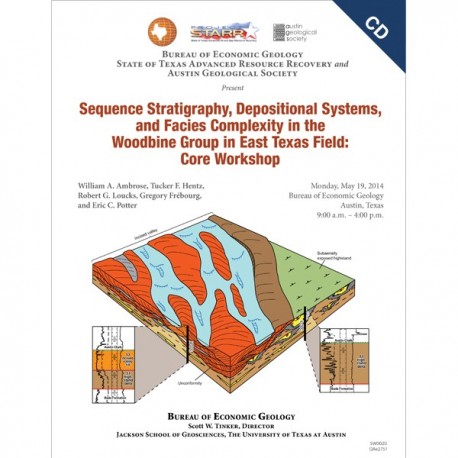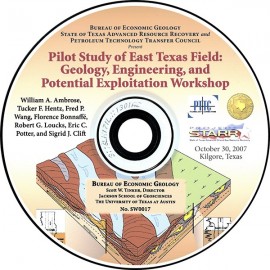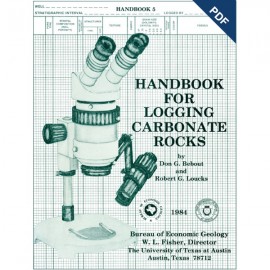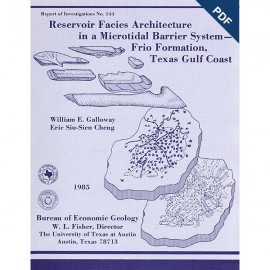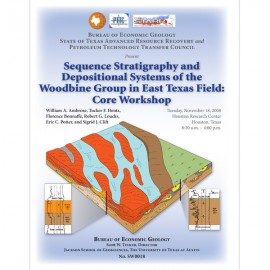Seminars and Workshops
-
Books & Reports
- Reports of Investigations
- Guidebooks
- Udden Series
- Geological Circulars
- Down To Earth
- Atlases of Major Oil and Gas Reservoirs
- Texas Memorial Museum Publications
- Environmental Geologic Atlas of the Texas Coastal Zone
- Mineral Resource Circulars
- Other Reports
- Seminars and Workshops
- Handbooks
- Submerged Lands of Texas
- Symposia
- Annual Reports
- Open File Reports
-
Maps & Cross Sections
- Thematic Maps
- Miscellaneous Maps, Charts & Sections
- Geologic Atlas of Texas
- STATEMAP Project Maps
- Geologic Quadrangle Maps
- Cross Sections
- Highway Geology Map
- Energy and Mineral Resource Maps
- Shoreline Change and Other Posters
- Wilcox Group, East Texas, Geological / Hydrological Folios
- Bouguer Gravity Atlas of Texas
- River Basin Regional Studies
- Featured Maps
- Posters
- Teachers & the Public
-
Geological Society Publications
- Gulf Coast Association of Geological Societies
- Alabama Geological Society
- Austin Geological Society
- Corpus Christi Geological Society
- Houston Geological Society
- Lafayette Geological Society
- Mississippi Geological Society
- New Orleans Geological Society
- South Texas Geological Society
- GCS SEPM Publications
- Historic BEG & UT Series
Sequence Stratigraphy...Woodbine Group...East Texas Field: A Core Workshop
SW0020CD
Sequence Stratigraphy, Depositional Systems, and Facies Complexity of the Woodbine Group in East Texas Field: Core Workshop, by W. A. Ambrose, T. F. Hentz, R. G. Loucks, Gregory Frébourg, and E. C. Potter. 2014. CD-ROM
SW0020CD. Sequence Stratigraphy, Depositional Systems, and Facies Complexity of the Woodbine Group in the Woodbine Group in East Texas Field: Core Workshop, by W. A. Ambrose, T. F. Hentz, R. G. Loucks, Gregory Frébourg, and E. C. Potter. 2014. CD-ROM.
To purchase this publication in book format, please order SW0020.
To purchase this publication as a downloadable PDF, please order SW0020D.
From the Introduction
Cores in the Woodbine Group in East Texas field display a variety of deltaic and fluvial facies. This workshop presents cores from fluvial-dominated deltaic deposits in the central and south parts of the field (Shell No. 55 Watson, ARCO No. 21-X Kinney, and ARCO No. C-19 Pinkston wells) and coarse-grained incised-valley-fill fluvial deposits in the north part of the field (ARCO No. B142 King and Cities Service No. B2 Killingsworth wells) (Fig. 1).
Cores are useful in understanding reservoir architecture because they display a vertical profile of rock fabric, contacts between beds, and sedimentary structures. Vertical trends in lithology, grain size, and stratification record changes in sedimentary processes and depositional environments through time. Workshop participants will observe numerous examples of vertically superimposed sedimentary facies from deltaic, fluvial, and transgressive-shelf depositional systems.
Keywords: core, depositional systems, East Texas field, sequence stratigraphy, Texas, Woodbine Group
Citation
Ambose, W. A., Hentz, T. F., Loucks, R. G., Frébourg, Gregory, and Potter, E. C., 2014, Sequence Stratigraphy, Depositional Systems, and Facies Complexity of the Woodbine Group in East Texas Field: Core Workshop: The University of Texas at Austin, Bureau of Economic Geology, SW0020, 26 p.
